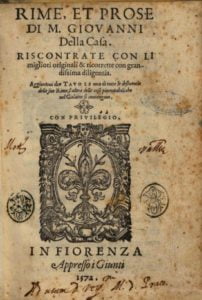Conduct Books
 Another type of printed source of use to the Refashioning the Renaissance project are texts that fall under the broad category of ‘conduct books’. This vast body of literature offered a broad range of advice to a broad range of readers, from how to be the perfect courtier to how to be the perfect nun. Many of these books were dedicated to aristocrats or other elite members of society and spoke to an educated, wealthy reader, sometimes in Latin. There were many books written in the vulgate, though, and that could be purchased for a low price by middle-class readers, if not upwardly-mobile artisans. These kinds of texts suggested, in general terms, how one should dress, comport their body, and – for example – blow their nose politely!
Another type of printed source of use to the Refashioning the Renaissance project are texts that fall under the broad category of ‘conduct books’. This vast body of literature offered a broad range of advice to a broad range of readers, from how to be the perfect courtier to how to be the perfect nun. Many of these books were dedicated to aristocrats or other elite members of society and spoke to an educated, wealthy reader, sometimes in Latin. There were many books written in the vulgate, though, and that could be purchased for a low price by middle-class readers, if not upwardly-mobile artisans. These kinds of texts suggested, in general terms, how one should dress, comport their body, and – for example – blow their nose politely!
Although these texts do not give us detailed information of the latest styles or the most fashionable types of dress, they do present modern readers with an idea of aspects of behaviour and physical appearance deemed appropriate or desirable or not in Renaissance Europe. Understanding good manners and how to comport yourself would have been important for artisans that dealt directly with their clients, especially those of a higher social status. The contents of books on conduct would also, perhaps, have been of interest to those wanting to present themselves well when out in the city or entertaining friends at home. Records such as household inventories show that some artisans owned quite expensive garments and perhaps would have wanted to display their good manners along with their fine clothes.
Suggested reading:
Rudolph M Bell, How to Do It: Guides to Good Living for Renaissance Italians, 2nd ed. (Chicago: University of Chicago Press, 2010).
Elizabeth Currie, “Prescribing Fashion: Dress, Politics and Gender in Sixteenth-Century Italian Conduct Literature,” Fashion Theory4, no. 2 (May 2000): 157–77, https://doi.org/10.2752/136270400779108780.
Helena Sanson and Francesco Lucioli, eds., Conduct Literature for and about Women in Italy, 1470-1900: Prescribing and Describing Life / Edited by Helena Sanson and Francesco Lucioli., Women and Gender in Italy (1500-1900) ; 1 (Paris: Classiques Garnier, 2016).
Gabriella Zarri, ed., Donna, Disciplina, Creanza Cristiana Dal XV Al XVII Secolo : Studi e Testi a Stampa(Roma: Edizioni di storia e letteratura, 1996).
Image: Title page from Giovanni Della Casa, Rime (Galateo) (Bernardo I Giunta: Florence, 1572), where we are instructed not to look inside our handkerchief after blowing our nose, as if we have produced pearls or rubies! (p. 7v)

